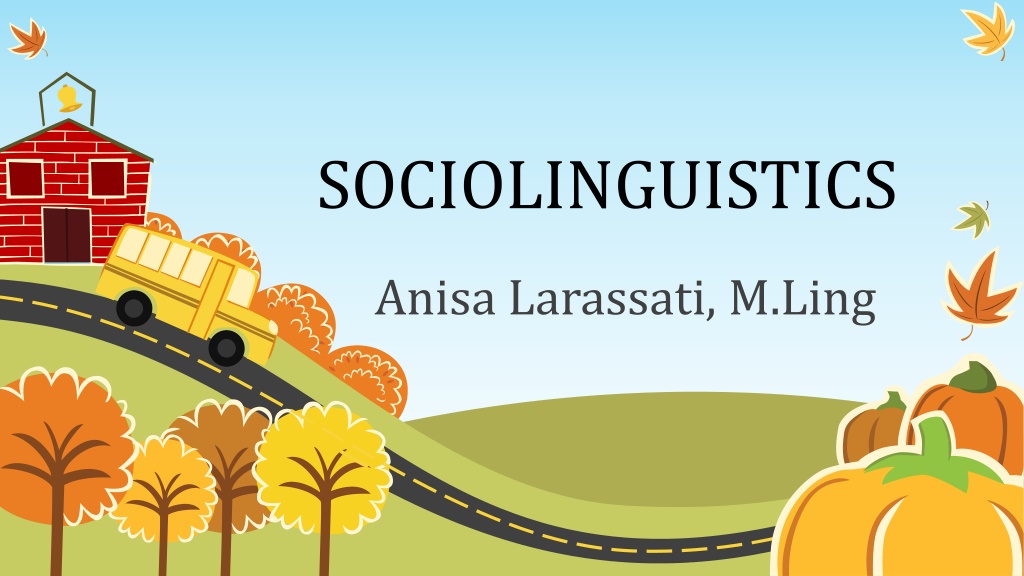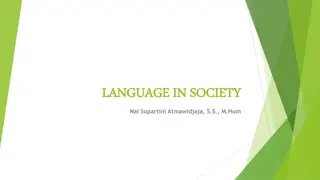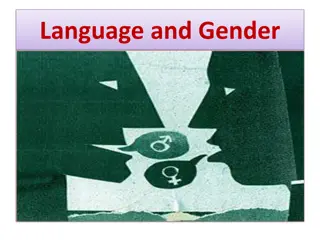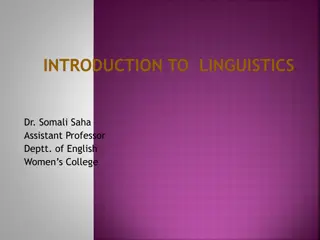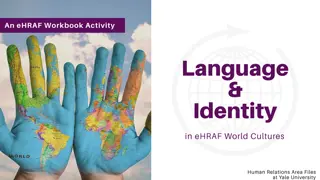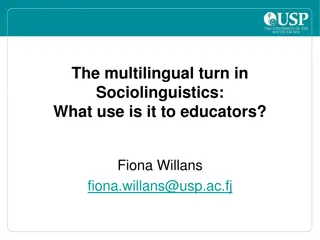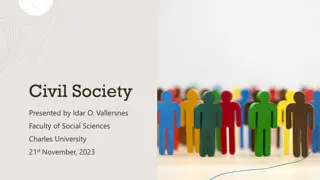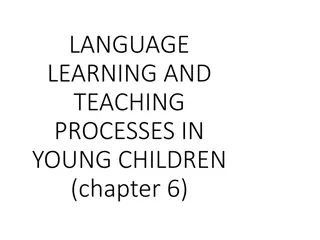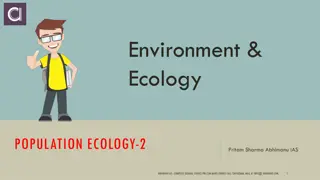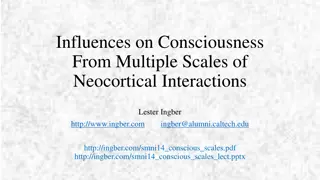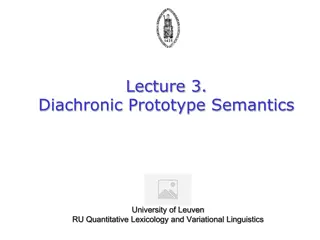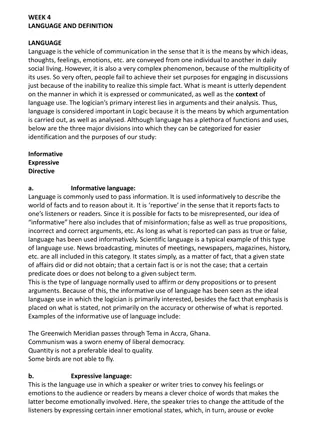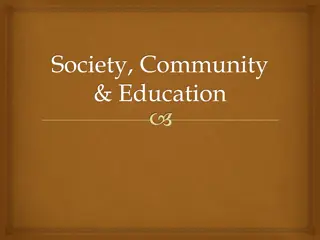Understanding Sociolinguistics: Language and Society Interactions
Sociolinguistics is the study of the relationship between language and society, analyzing how language reflects and shapes social structures. It explores the uses of language within different communities, addressing power dynamics and societal norms. Sociolinguists examine language patterns, attitudes, and influences on communication through various methods such as analyzing speech recordings and studying language planning sources.
Download Presentation

Please find below an Image/Link to download the presentation.
The content on the website is provided AS IS for your information and personal use only. It may not be sold, licensed, or shared on other websites without obtaining consent from the author. Download presentation by click this link. If you encounter any issues during the download, it is possible that the publisher has removed the file from their server.
E N D
Presentation Transcript
SOCIOLINGUISTICS Anisa Larassati, M.Ling
Lecture 1 Introduction 2018/2019
KEY CONCEPTS What is sociolinguistics? Sociolinguistics vs Sociology of Language What does sociolinguist study?
WHAT IS SOCIOLINGUISTICS? Sociolinguistics is the field that studies the relation between language and society, between the uses of language and the social structures in which the users of language live (Spolsky, 1988, p.3). Sociolinguistics deals with the inter-relationships between language and society. It has strong connections [ ] to sociology, through the crucial role that language plays in the organization of social groups and institutions. (Yule 1996, p. 239)
WHAT IS SOCIOLINGUISTICS? By society, we mean a group of people who are drawn together for a certain purpose or purposes; The term language means a system of linguistic communication particular to a group; this includes spoken, written, and signed modes of communication. (Wardhaugh, 2015, p.2)
WHAT IS SOCIOLINGUISTICS? Thus, while in sociolinguistics we do analyze speech with the goal of making generalizations, we also question these generalizations and examine how they, in turn, influence how we use language. Sociolinguistics is not a study of facts (e.g., men call each other nicknames) , but the study of ideas about how societal norms are intertwined with our language use (e.g. what it means to be a male or female member of a particular society may influence the terms we use to address each other) (Wardhaugh, 2015, p.1)
WHAT DOES SOCIOLINGUISTS STUDY? HOW? Sociolinguists study the way that language is used in normal life, by all kinds of people, to accomplish all manner of goals is the subject of our attention. Language lets us do things and as such can be used to exercise or resist power. Sociolinguists use a range of methods to analyse patterns of language in use and attitudes towards language in use.
WHAT DOES SOCIOLINGUISTS STUDY? HOW? Study language pattern trough: Close examination of recorded speech, speaker s background/ place in community (ex: research on dialects) Library research, archive, newspaper, magazine, school textbooks (ex: research on language planning)
WHAT DOES SOCIOLINGUISTS STUDY? HOW? Sociolinguists are interested in both social and linguistic questions. Some sociolinguistics research has more to say about social issues, and some sociolinguistic research has more to say about linguistic matters. Regardless of its emphasis, it has something to say about both linguistic structure and social structure. (Meyerhoff, 2006, p.3)
HOW DO SOCIOLINGUISTS WORK? What are the social factors involved? What social dimensions are involved in sociolinguistic analysis? Solidarity / social distance: intimacy vs. distance of interlocutors Participants: who talks to whom? Setting: where are they speaking? Status / power: superiority vs. subordination of interlocutors Topic: what are they talking about? Formality: high vs. low formality (setting / type of interaction) Function: why are they speaking? Function: referential ( objective information content, e.g. news report) vs. affective function (subjective, affective content, e.g. tell about feelings)
MICRO-SOCIOLINGUISTICS VS MACRO-SOCIOLINGUISTICS (WARDHAUGH, 2015, P. 15) Sociology of Language (Macro- Sociolinguistics) Sociolinguistics (Micro-Sociolinguistics) the study of society in relation to language the study of language in relation to society studies what societies do with their languages, that is, attitudes and attachments that account for the functional distribution of speech forms in society, language shift, maintenance, and replacement, the delimitation and interaction of speech communities how social structure influences the way people talk and how language varieties and patterns of use correlate with social attributes such as class, sex, and age Goal: better understanding the structure of language and how languages function in communication Goal: discover how social structure can be better understood through the study of language The structure of language The structure of society
TYPES OF SOCIOLINGUISTICS STUDIES Correlational studies : relate two or more variables (e.g., certain linguistic forms and social-class differences, e.g.: ndes ) Micro-linguistic studies : i.e. focuses on very specific linguistic items or individual differences and uses in order to search for possibly wide ranging linguistic and/or social implication (e.g. the distribution of singing and singin ) Discourse analysis : i.e. studies of conversational structure and how speakers use language for their special purposes (how we begin and end conversations, how this depend on the relationship between interlocutors)
TYPES OF SOCIOLINGUISTICS STUDIES Macro-linguistic studies : i.e. studies that examine large amounts of language data to draw broad conclusions about group relationships ( e.g. choices made in language planning, language shift) Critical analyses : i.e. how language is used to create and perpetuate power structures. May overlap with discourse analysis and macro-linguistic studies (e.g. how people talk about multilingualism could be analyzed in discourse, or language planning and policies related to multilingualism)
SCOPE OF SOCIOLINGUISTICS Language planning and standardization (mostly related to prescriptive) Language and identity (gender, age, ethnicity) Language and power etc Language varieties Language attitude Language choice Language shift Language documentation and maintenance
PRESCRIPTIVISM VS DESCRIPTIVISM Prescriptivism Descriptivism Recommends how language should be use Observe and records how language actually is used (ex. Malaysian English Video) Example: I m right behind you, aren t I? I can t see you. Example: I m right behind you, what? I can t see you also.
CAN YOU PREDICT? - Oh sh*tthis is so sick! - It ain t no big deal. - Close the door, will ya! - Oh my, this is so adorable, isn t it? - It s all right, love. - Could you close the door, please? Gender? Gender? Social class? Social class? Ethnicity? Ethnicity? Power relation? Power relation? See African American Vernacular English See Lakoff, R. (1975) Tag questions, empty adjective, italics, super polite form, terms of endearment
NOW HOW ABOUT THIS? Will it be possible and/or acceptable: cEmuNguTzz eaa K4k4k.. aquW cLalu c4yanX K4k4k.. Mu4ch..!?! The dean sends a message to all the lecturers Gender? Age? H4ri In! RaP4T Eaa.. Social class?
JARGON ACTIVITY List jargon words in the field of sociolinguistics Provide definitions Examples: Code-switching - Ethnography - Isolect Code-mixing - Pidgin Vernacular - Creole Lingua Franca - Dialect Diglossia - Accent Gender - Idiolect
Lecture 2 Variation and Language 2019/2020
LANGUAGE AND VARIETIES All languages exhibit internal variation Each language exists in a number of varieties Variety: general term for a way of speaking
VARIABLE AND VARIANTS Variable : abstract representation of the source of variation. Realised by two or more variants. Cheers Variant: the actual realization of a variable. Analogous to the phonetic realisations of a phoneme. variable [ [ Example from Bequia (/ b kwi / or / b kwe /) ] variant ]variant The word cheers is pronounced [ ] and [ ] (Meyerhoff, 2006, p. 9)
REGULAR VS PROBABILISTIC ALTERNATION BETWEEN VARIANTS Free Variation The idea that some variants alternate with each other without any reliable constraints on their occurrence in a particular context or by particular speakers. Regular / Constrained If the distribution for variants is neither random nor free There are some linguistic constraints Example from English No clear linguistic constraints Aspirated [ph] in the beginning of a word Free = unconstrained Verbs ended in ed : [d] after voiced consonants [t] after voiceless consonants [Id] after [t] or [d] Javanese [h ] [h [h ] m]
REGULAR VS PROBABILISTIC ALTERNATION BETWEEN VARIANTS Regular / Constrain Regular / Constrained Verbs ending in -ed [P] variable [ ] = played [pl [ ] = brushed [b [ ] = painted [ d] ] [p] in [st p] [p ] in [p ] d] variant variant
REGIONAL DIALECTOLOGY The identification and mapping of boundaries between different varieties on the basis of clusters of similar and different features in particular region, towns or villages Atlas Linguistique de la France or Alf Jules Gillieron & Edmond Edmont Anibal Otero (1911 1974) in Spain 1936 Dave Britain s study of English spoken in Fens, London
REGIONAL DIALECTOLOGY (Dave Britain s study in Fens. Meyerhoff, 2006: 13-15) SOUTH FENS NORTH & WEST FENS STRUT / / STRUT / / WEST FENS EAST FENS PRICE / Night /n Tide /t / PRICE / Night /n Tide /t / t/ t/ d/ d/
REGIONAL DIALECTOLOGY (Dave Britain s study in Fens. Meyerhoff, 2006: 13-15) Starting in the 18th century the swampy areas of the Fens began to be drained, and communication between villages became much easier and increasingly frequent Some of the regional differences began to disappear Regional variation can highlight the importance of non-linguistic factors Sociolinguists have to think about a whole range of different issues when analyzing data: Linguistic structure Aspect of social structure How speaker conceive of themselves and relate to others Britain s study provides an excellent entry point for exploring more closely how regional dialectology expanded into social dialectology.
SOCIAL DIALECTOLOGY The study of linguistic variation in relation to speaker s participation or membership in social groups, or in relation to other non-linguistic factors. Labov sMartha s Vineyard study 1960s Zane Goebel s Study in Semarang (1990s)
ZANE GOEBELS FINDINGS RT 05 Inter-ethnic RT 08 Inter-ethnic Symmetrical Ngoko Indonesian Intra-ethnic Intra-ethnic Symmetrical Ngoko Symmetrical Krama Influenced by: Income Housing designs/ social space Familiarity Participants interaction history
DATA COLLECTION AND ANALYSIS (WARDHAUGH, 2015: 157) Once investigator has made some decision concerning which social variables must be taken into account and has formed a hypothesis about a possible relationship between social and linguistic variation, the next task: Collecting data to confirm or refute the hypothesis Collecting relevant data Collecting data from a representative sample of speakers Problems with data collection: Observer s Paradox The aim of sociolinguistic research is to study how people speak when they are not being observed, but the data are only available through systematic observation.
Lecture 3 Variation & Style 2019/2020
ACCENT AND DIALECT Accent: the variation at the level of pronunciation only (phonetics and/ or phonology) Dialect: Sub-varieties of a single language Differ on more than just pronunciation Vocabulary Sentence structure
ACCENT AND DIALECT Dialect All speakers have an accent. Accent Vocabulary Rhythm Pronunciation Grammar Intonation
LANGUAGE OR DIALECT? (Wardhaugh, 2015: 29-32) The common criterion used to determine if two varieties are dialects of the same language or distinct languages is that of mutual intelligibility. Mutual intelligibility: if speakers can understand each other, they are speaking dialects of the same language, if they cannot, they are speaking different languages. Javanese Semarangan and Banyumasan (Ngelih, Kencot) Javanese Semarangan and Pati (Nggonmu, Nggonem) What about Bahasa Indonesia in Indonesia and Bahasa Melayu in Malaysia?
LANGUAGE OR DIALECT? (Wardhaugh, 2015: 29-32) Problems with mutual intelligibility: 1. It s not an objectively determined fact. Some speakers of (standard) German can understand (standard) Dutch, while others may find it incomprehensible. One s ability to understand someone who speak. differently may vary. 2. Dialect continuum Speakers of some varieties of German can understand varieties of Dutch better than they can understand other varieties of German. It makes it apparent that the lines drawn between languages are not based on linguistic criteria. http://www.heardutchhere.net/duengero.html
LANGUAGE OR DIALECT? (Wardhaugh, 2015: 29-32) Problems with mutual intelligibility: 3. Distinct languages that are mutually intelligible Hindi and Urdu are very similar in spoken form, but there are political and religious reasons that make them considered as different language. The difference is based on sociopolitical ideology of language, not on any clear and objective linguistic difference. Hindi written left to right in the Devanagari script used in India. Urdu written right to left in Arabic Persian Script used in Pakistan. 4. Unintelligible dialects which are identified by speakers as being the same language Example in China: Cantonese and Mandarin share the same writing system but very different in spoken form, yet the speakers considered Cantonese and Mandarin are dialects of the same language. For the Chinese, a shared writing system and a strong tradition of political, social, and cultural unity form essential parts of their definition of language.
The Standard-Dialect Hierarchy (Wardhaugh, 2015: 37-38) Standard variety of any language is actually only the preferred dialect of that language: Parisian French, Florentine Italian, and the Zanzibar variety of Swahili in Tanzania. It is the variety that has been chosen for some reason, perhaps political, social, religious, or economic, or some combination of reasons, to serve as either the model or the norm for other varieties. As a result, the standard is often not called a dialect at all, but is regarded as the language itself. Calling something a dialect of particular language implies that that language has at least two dialects, But calling something a language does not necessarily entail that it has subordinate dialects.
SOCIAL DIALECT (WARDHAUGH, 2015 : 42 43) Whereas regional dialects are geographically based, social dialects originate among social groups and are related to a variety of factors: Social class Religion Race/ethnicity Example: India, caste become the factor determining which language varieties the people use Baghdad The Christians, Jews, and Muslims use different varieties of Arabic The Muslim variety is the lingua franca The Jews and Christian use two varieties, their own at home and the lingua franca
AFRICAN AMERICAN VERNACULAR ENGLISH (AAVE) (MEYERHOFF, 2006: 48)
AFRICAN AMERICAN VERNACULAR ENGLISH (AAVE) (WARDHAUGH, 2015: 46-50) FEATURES OF AAVE Phonological level Consonant cluster reduction: e.g. desk, task, end R-lessness (commonly in unstressed syllables): e.g. over, brother, forget, four /ai/ monophtongization th / / pronounces as /t/, /d/, /f/, or is deleted: e.g. think [ ], both [bout] / / pronounces as /d/ or /v/: e.g. that [ ], mother [ ] [ v ] Vocalization to schwa / /, e.g. feel /fi /
AFRICAN AMERICAN VERNACULAR ENGLISH (AAVE) (WARDHAUGH, 2015: 46-50) FEATURES OF AAVE Morphological, Syntactic, Grammatical level Verbal s marking Present or absence of the suffix s on finite verb E.g. she likes cheese she like cheese The men has wives Zero Copula He is nice He nice Habitual be It is called habitual because it marks an action which is done repeatedly, that is habitually. They be throwing the ball the people currently throwing a ball They be throwing the ball = they often get together and throw a ball back and forth They be throwing the ball they (are) throwing the ball something that is happening at the current time Double negation I ain t got no homework
AFRICAN AMERICAN VERNACULAR ENGLISH (AAVE) (WARDHAUGH, 2015: 46-50) DEVELOPMENT OF AAVE Anglicist hypothesis (Kurath, 1949 & McDavid, 1965): AAVE had no characteristics that were not found in other varieties of English AAVE just another dialect of American English Black speakers may produce greater quantities of certain nonstandard usages is merely a peculiarity of the style of speaking they have adopted Neo-Anglicist hypothesis (Wolfram, 2003 & Wolfram and Thomas, 2002): Early African Americans maintain certain features of the languages they brought with them while at the same time accommodating to the local dialects of English.
AFRICAN AMERICAN VERNACULAR ENGLISH (AAVE) (WARDHAUGH, 2015: 46-50) DEVELOPMENT OF AAVE Creolist AAVE is of creole origin, and therefore a variety of English which originated quite independently of Standard English AAVE is not a dialect of English but a creolized variety of English Divergence Hypothesis Claims that AAVE is diverging from other dialects of English, particularly standard varieties Butters (1989) argues that there is no solid evidence to support such a claim, pointing that there are both divergent and convergent features. AAVE is just like any other dialect of English; it has its own innovations but remains strongly influenced by the standard variety.
Lecture 4 Language Attitudes 2019/2020
Language Attitude When you talk to someone, you start to form opinions about them, sometimes solely on the basis of the way they talk (Chambers 2003: 2-11). Language provides many windows on speakers attitudes to themselves and others. Our everyday speech encodes a surprising amount of information on our attitudes.
GENDER, LANGUAGE AND ATTITUDES: Semantic shift and semantic derogation How attitudes to women and men are reflected in language? Semantic shift Gay Early meaning: joy and mirth 19th century: related to sexual promiscuity, women who were sexually promiscuous 20th century: homosexual Pretty Cunning, skillful Gallant or brave Pleasant
GENDER, LANGUAGE AND ATTITUDES: Semantic shift and semantic derogation Semantic derogation: when a word s meaning shifts and acquires more negative connotations. There was a distinct tendency for words describing women to have acquired negative overtones (bitch, tart, minx) while this was not true for words about men. The word for women also linked some kind of sexual activity with negative attitudes, in a way that was not paralleled by the words for men. e.g. master vs mistress See. Meyerhoff, 2006, p.58
GENDER, LANGUAGE AND ATTITUDES: Semantic shift and semantic derogation The linguistic derogation of women can be seen in may cultures. E.g. aphorisms and sayings in Moroccan Arabic: 1. Only death can control girls 2. Your mother, then your mother, then your mother and then your father. 3. The old woman is worse than the devil. A mother is to be treasured beyond all others, but before she starts having children and after she stops, a woman is seen in very negative terms.
LINGUISTIC RELATIVISM LINGUISTIC RELATIVISM or SAPIR-WORF HYPOTHESIS The way we talk about others, and the words we use, does more than simply denote entities or events in the world. The way we perceive the world plays a part in how language is structured.
Gender Bias & Sexist Language Biased language makes unnecessary distinctions about gender, race, age, economic class, sexual orientation, religion, politics, or any other personal information that's not necessary to a text's argument or intent. http://www.wilkes.edu Gender-biased language implies that people are male unless 'proven' to be female. Female gender may be designated by either tagging on a feminine descriptor (e.g. lady professor, women doctor, female engineer) or by belonging to a stereotypically female group (e.g., kindergarten teacher, social worker). (Janet B. Ruscher, Prejudiced Communication: A Social Psychological Perspective. Guilford, 2001)
Gender Bias & Sexist Language (Cont) Sexism is the belief that one sex is innately superior to the other. It underlies patriarchy and harms men, women, and the society as a whole. It is discrimination on the basis of gender. The tendency to speak of people as cultural stereotypes of their gender
